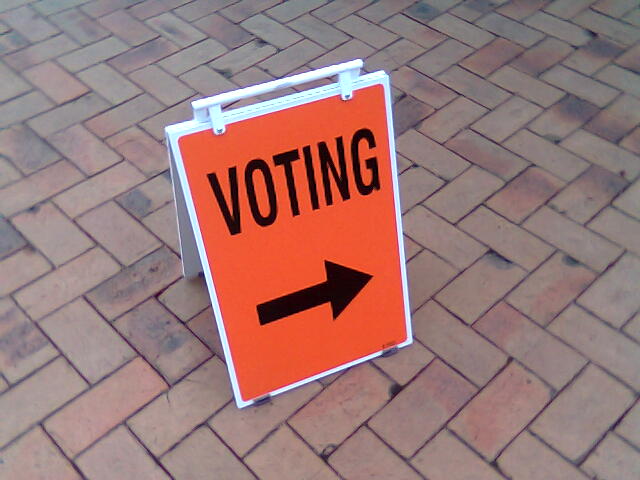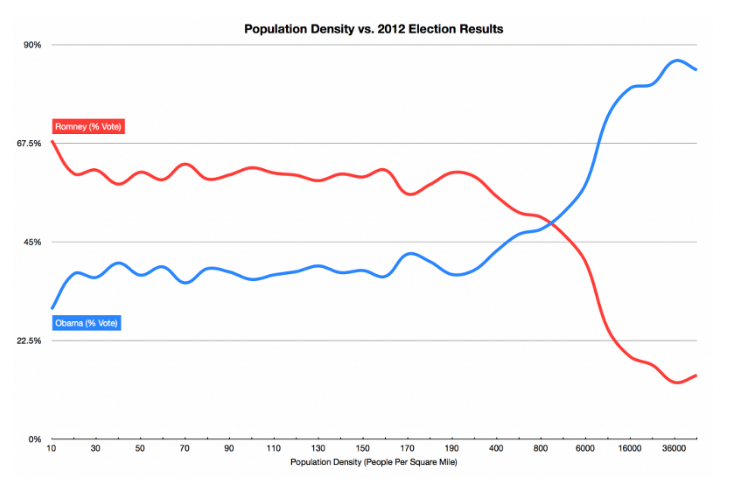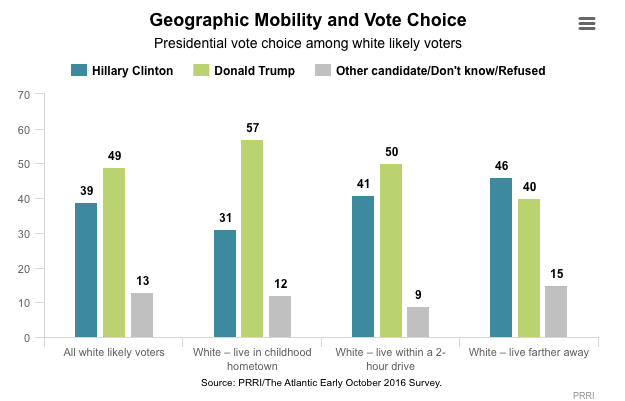It’s election day, 2016. Here’s some of what we know about cities and voting.
Well, at last. Today is election day. While we’re all eagerly awaiting the results of the vote, we thought we’d highlight a few things we know about voting, especially as they relate to cities. Its food for thought as we get ready to digest and understand the results today’s elections.

Democrats and density
In the past few elections, there’s been an increasingly strong relationship between population density and the share of the vote going to the democratic candidate. Dave Troy has plotted county level election returns from 2012 against population density. Low density counties voted overwhelmingly for Mitt Romney; higher density ones voted for Barack Obama. That same pattern is likely to be in evidence today.
As a result, as Emily Badger wrote in The New York Times last week, the Republican party has essentially abandoned cities in presidential elections.
Homeowners are voters
Regular readers of City Observatory are very familiar with the homevoter hypothesis propounded by William Fischel, which observes that homeowners participate actively in the formation of local policies, as a way of protecting and enhancing the value of their homes. The practical implication is that homeowners support density restrictions and other policies that tend to raise home values and rents. In contrast, renters are generally under-represented in the electorate, especially in purely local elections. More data on that point was presented recently by the website ApartmentList.com. According to tabulations of self-reported data from the Census, for voting in the 2012 general election, about 77% of homeowners vote, compared to only 58% of renters – in other words, homeowners are 25% more likely to make their voice heard in an election. Part of the difference is explained by length of tenure—homeowners have generally lived in their houses longer than renters, but homeowners are more likely to vote than renters for any given length of tenure. Homeowners who have lived in their homes for 1-2 years are more likely to vote than renters who have lived in their homes for more than five years.
The gerontocracy of local elections
A new study from Portland State University takes a close look at the demographics of voter turnout in local elections. (Full disclosure: it’s lead authors include our friends and colleagues Phil Keisling and Jason Jurjevich). Their final report, “Who votes for Mayor?” provides a detailed look at turnout patterns in 50 of the nation’s largest cities. A particular virtue of this study is that it uses data from election records—more than 22 million in all–rather than after-the-fact surveys, which can be subject to mis-reporting (respondents may be reluctant to tell pollsters than they didn’t vote). Among their key findings: older people are much more likely to vote, especially in purely local elections than are younger ones. In cities, the variation in turnout by age heavily skews who chooses mayors and other local leaders. In the typical local election, the median voter is a full generation older than the overall electorate. As a result, at the municipal level, we have a gerontocracy, rather than a fully functioning democracy.
Moving and voting
Recent survey data for the current election, collected in September, zeroed in on an interesting aspect of voter preference: whether someone lived in or near the place where they were born. Summarizing the results of the Atlantic/PRRI survey, Daniel Cox and Robert Jones examined the presidential preference of white voters based on how close they lived to where they were born. Whites who reported living in their childhood hometown favored Trump 57 to 31 percent; those who lived outside their home town, but within two hours favored Trump 50 to 41 percent, and those who lived more than two hours away favored Clinton 46 to 40 percent. Of course, migration is a non-random and self-selected behavior, and is strongly correlated with education. But a key point here is that those whites who’ve chosen to move and live in different places are statistically more likely to favor Hillary Clinton than Donald Trump.
In this election—as in every election—many key urban issues, including age, education, migration, density and homeownership—play important roles in shaping electoral outcomes. In the next few days we’ll be examining the results of the 2016 election to see what role each of these factors has played.


